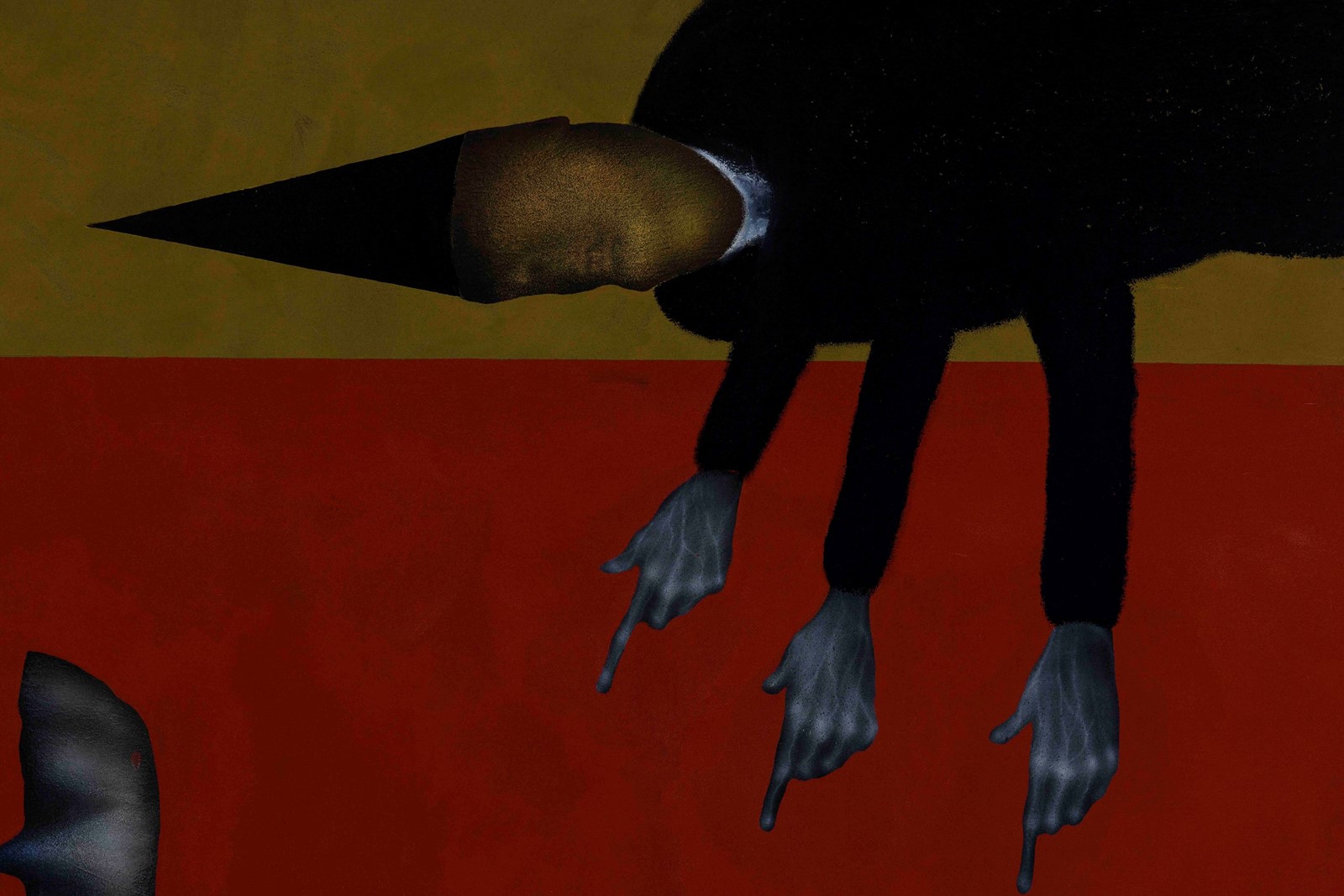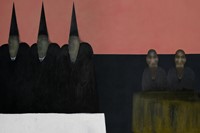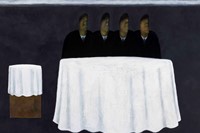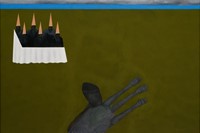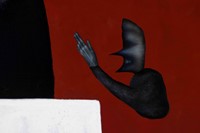Art historian, curator and writer Alayo Akinkugbe is behind the popular Instagram page A Black History of Art, which highlights overlooked Black artists, sitters, curators and thinkers, past and present. In a column for AnOthermag.com titled Black Gazes, Akinkugbe examines a spectrum of Black perspectives from across artistic disciplines and throughout art history, asking: how do Black artists see and respond to the world around them?
Pol Taburet is a 28-year-old Paris-based artist who has experienced a meteoric rise over the past few years. His paintings are characterised by bold, acidic blocks of colour and supernatural hybrid figures, which he also creates as sculptures. Taburet uses a signature combination of techniques that include airbrushing, acrylic and oil paint.
A new series of paintings in his exhibition Oh, If I Only Could Listen, presents a different chapter in his practice; they evoke a fresh yet distinctly macabre perspective. Influenced partly by his time spent with Francisco Goya’s series of Black Paintings at the Prado Museum in Madrid, and contending with the personal loss of his grandmother, Taburet has used a darker, more subdued palette. His new paintings create a sense of violence, yet, as he notes, “if you look at them, nothing violent is happening.”
The exhibition, the latest by Fundacion Sandretto Re Rebaudengo Madrid, is set within the iconic glass-and-brick Pabellón de los Hexágonos in Madrid. The pavilion – which won a Gold Medal at the 1958 Brussels World Fair – is reactivated by Taburet’s paintings. They introduce a sense of the surreal, placed side-by-side with the surrounding woodland framed by broad panes of glass, while some works seem to float, covertly attached to metal columns.
Below, Pol Taburet discusses the influence of writers like Ben Okri and Samuel Beckett on his practice, his love of the visuals in OutKast music videos and how watching his mother paint Black figures as saints introduced him to painting. He also shares his desire to create a sense of distance between the viewer and the scenes they are witnessing in his new body of work.
Alayo Akinkugbe: The title of your exhibition is Oh, If Only I Could Listen. Where does this phrase come from?
Pol Taburet: The idea of the show was based on two subjects: limbo and the hunt. Imagine the paintings are [in their own] world and you cannot access it. That would be limbo; this kind of waiting room between paradise and hell. The idea was for people to not be able to be in a conversation with them. Usually, in my paintings [there is] some character that lets you into the [image] and watches you. In this series, I want there to be a [sense of] distance.
It’s also partly inspired by the fact that my grandmother passed away and the feeling of not being able to reach her and not being able to hear her. It’s this kind of distance between what’s happening in this world – of [those] who are alive – and [those] in the other world.

AA: When did you first start painting, and what first attracted you to it?
PT: I always drew when I was a kid and my dad would also draw a lot, because I would ask him to draw me cartoon scenes. I would ask him to paint me a “skeleton fight”, or a wolf, and stuff like that. But the main thing was that my mum was also a painter. I consider her an artist, she’s very good. I would watch her from when I was around eight to 12 years old, painting every night. She would paint in front of the TV and I would stay up beside her watching her paint night after night. I think that was my first encounter with somebody making art.
AA: You paint from TV and film stills, sometimes, like she did.
PT: Absolutely. I think I’m 50/50 inspired by the history of art and by videos. OutKast videos were a big inspiration for me but also trap music videos, which have a different type of liberty to their clips. At that time it was not very common, but my mum was painting Black figures as saints. She would paint someone from the hood as a saint and she would play with stereotypes. She’d portray the guys that society may consider to be “bad boys” posing like religious icons. She could have been a big star, my mum. Maybe if she’d been a star I wouldn’t paint.
“Some of the new paintings will be considered as violent, but if you look at them nothing violent is happening” – Pol Taburet
AA: Some influence for this body of work comes from Francisco Goya’s Black Paintings in the Prado. There are also the figures with conical hats, which allude to the garments worn during Catholic procesiones in Spain during Easter. What drew you to these dark images?
PT: The procesiones were part of my research. When I started to make these paintings, I was obsessed with making lists. I wanted to know which objects give us a sensation of violence; it was things like a nail, a needle, a fork or a knife. It is always something sharp and pointy that automatically gives violence to an image.
Some of the new paintings will be considered as violent, but if you look at them nothing violent is happening – they just give you that feeling. Whoever looks at the work will have a different reading [to the next person]. I like viewers to have an open reading, you will have your experience with the painting, I will have mine, and someone else will have another.
AA: Ben Okri wrote a poem for the exhibition catalogue, and you often refer to film and literature. Do you take influence from any other writers or filmmakers?
PT: I fell in love with Ben Okri’s writing recently. I’m not a good reader, and his work kind of allows me to have vision when I read it. I always look for this type of artist, whose work opens other spaces [for me]. [Samuel] Beckett is also very important. I like his novels because they’re quite dark; themes like this feed me a lot. I also included the Ghostface mask from the Scream films; I wanted to bring elements of contemporary culture into discussion with the history of art, because it could also be read as The Scream (1893) by Munch. Bob Thompson and Bill Traylor are two Black painters who inspired the show, and also the Italian painter Enzo Cucchi.
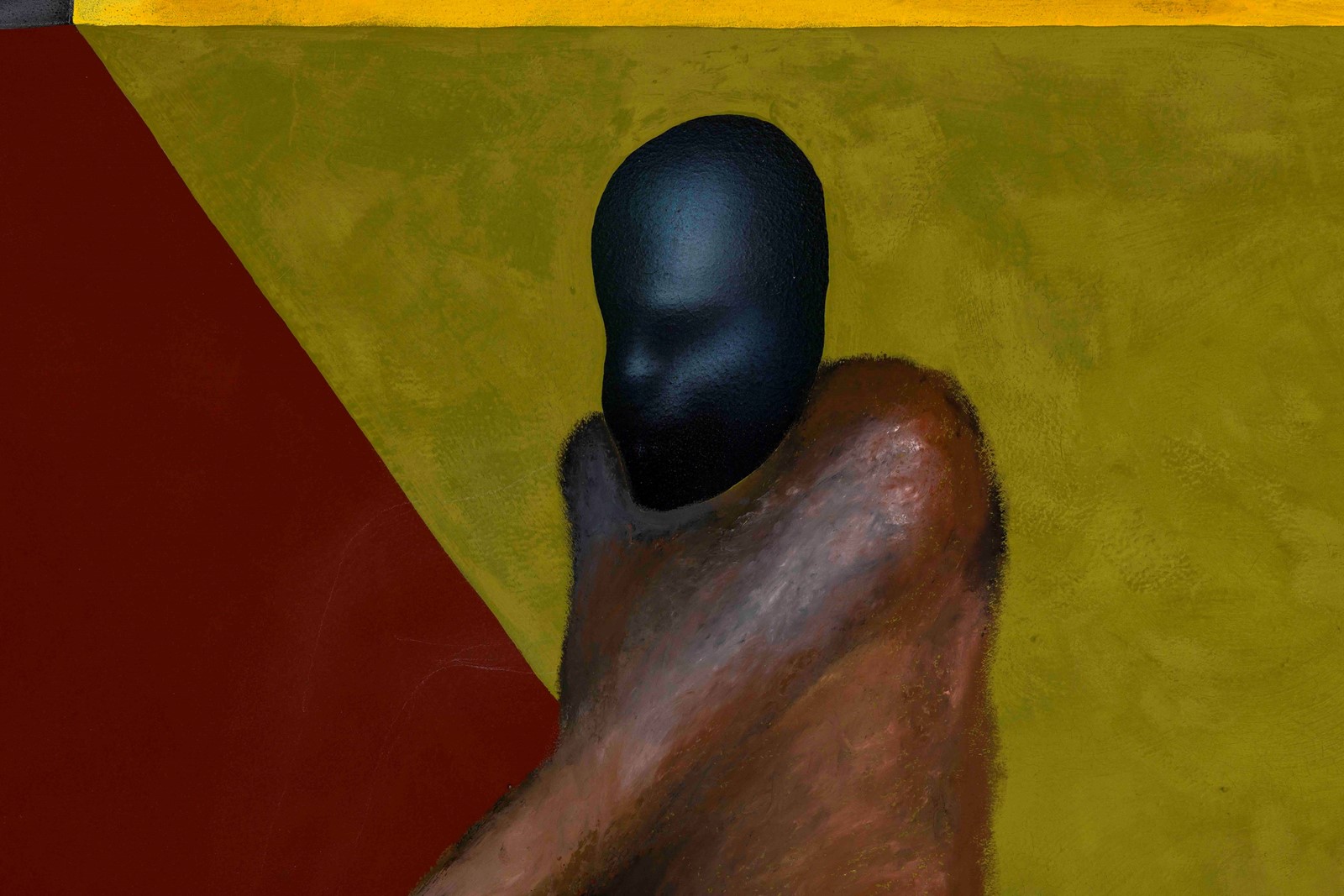
AA: You’ve spoken in the past about how your paintings may be read as fun or joyful through a child’s eyes, and more intensely through the eyes of an adult. With this exhibition, do you expect a different sort of interpretation?
PT: This series of paintings is a bit different to my previous work, it’s less seductive. My previous work had very colourful backgrounds, block colours and were a bit primal. They were something to seduce the eyes, to catch you. These are more hostile; they’re not the sort of paintings that charm you, they create distance and [contend] with you. The sensation that I want to provoke in the viewer this time is distance. If a child saw these, they may be afraid because there’s something more dark; they’re mystical but it’s a strange mysticism.
Oh, If I Only Could Listen by Pol Taburet is on show at Pabellón de los Hexágonos with Fundacion Sandretto Re Rebaudengo, Madrid until 20 April 2025.
